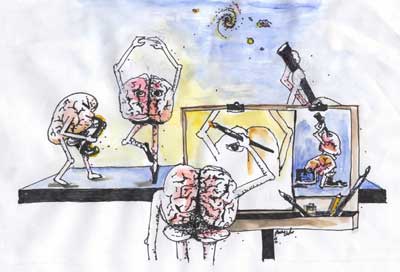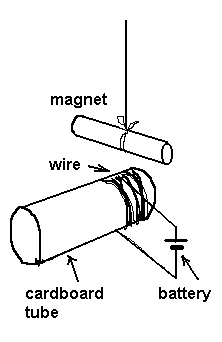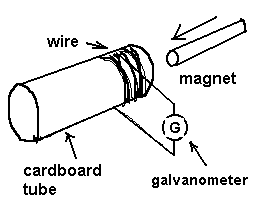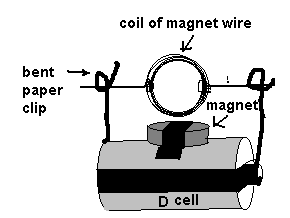 From Serendip | SCIENCE AS EXPLORATION INSTITUTE 2001 | 
|
MAGNETS AND CURRENTS
An Inquiry-Based Teaching Module
developed by Al Albano, Department of Physics, Bryn Mawr College
Scientific Content. This module is meant to introduce students to some of the magnetic effects of electric currents and the generation of electrical currents by the interactions of electrical charges and changing magnetic fields.
Assessment/Evaluantion.The assessment of what the students get out of the module involves asking them to design experiments that probe or generalize the basic concepts they are supposed to have learned.
Equipment and supplies. Galvanometer, cylindrical magnets and/or disk magnets, size D cells (a battery holder would be convenient), a flashlight bulb, a few meters of magnet wire, some lead wires, cardboard tube (e.g., empty paper towel tube), thread, and someplace from which a magnet attached to a string can be hung. Specs and suppliers and prices are listed on the last page.
So what? The "so what" in this case is obvious — the generation of electricity by mechanical means, taking advantage of electromagnetic induction, underlies the technologies of the 20th and, so far, the 21st centuries.
Logistics of transference to K-12. Here's where I need help from the teachers. This is probably appropriate for Middle School or High School.
Preliminaries.
Have the students play with the magnets. Have them make a magnetic compass by tying a string to the center of a cylindrical magnet and letting the magnet rotate freely. Have them identify the North Pole (N, "north-seeking pole") of each magnet. It shouldn't take them long to discover that "unlike poles attract, like poles …"
Question for discussion: Since a magnet's North pole points north, what kind of a magnetic pole is up there?
Have the students connect a flashlight bulb to a battery to make it light up — or show them how — so they realize that the battery must be connected properly in a closed circuit for there to be an electrical current in the circuit.
Electricity and Magnetism.
How can you use electricity to make a magnet move? Have them talk about it, and have them do experiments to check out their ideas. Eventually, have them wrap a few tens of turns (have them record how many turns) of magnet wire near the end of the cardboard tube, scratch the varnish from the ends of wire so that bare metal is exposed, put the coil near a suspended magnet and connect the ends to the battery (only momentarily or the wires may get too hot. See figure). The magnet should move, -- the current-carrying coil is behaving like a magnet.
Questions for further discussion/experimentation:
- Is the face nearer the magnet a North Pole or a South Pole?
- What happens if you reverse the connection to the battery?

- Does the effect of the coil on the magnet increase or decrease with distance? with number of coils?
How can you use a magnet to generate an electrical current? Have them connect the coil-on-a-cardboard-tube to the galvanometer so they can detect when there is a current in the coil. Have them talk about how they would try to use the magnet to make the galvanometer show a deflection. If they don't come across it themselves, have them quickly push a magnet into the coil as in the figure below.

Questions for further discussion/experimentation:
- Is there a current when the magnet is not moving?
- Does it matter if the magnet is pushed into the coil or pulled away from the coil?
- Does it matter if the N pole or the S pole of the magnet faces the coil?
- How can you make the deflection of the galvanometer larger (i.e., generate more current)?
An electric motor.
Have them build the electric motor shown in the figure below (there are better designs!). The coil can be made by wrapping magnet wire around the battery a few tens of times. The straight segments shown in the figure are the ends of the coil. Scrape off the varnish from one-half of the side (lateral surface) of one straight segment, and from the entire side of the other so that as the coil turns, the "half-scraped" segment is in electrical contact with one paper clip half of the time while the "fully-scraped" segment is in contact with its paper clip all of the time.
The disk magnet as well as the bent paper clip coil holders are attached to the D cell by electrical tape or rubber bands.
Get the "motor" started by making the coil turn about its axis. If it does not keep turning, check the electrical connections and the balance of the coil.
Question for discussion: How does the electric motor work?

Caveats
- "Hanging magnet" compasses won't point north if there are any other magnetized materials around. Beware of other magnets, steel cabinets, iron stands and the like.
- Even the metal jackets of batteries can be magnetized, so instead of using a battery to generate a current which generates a magnetic field which makes a magnet move, an enterprising student might just use a battery as a magnet!
- Balance is crucial to the operation of the simple motor. Make sure that the straight segments are along a diameter of the coil and are in the plane of the coil.
Suppliers and Specs.
Sargent-Welch, P. O. Box 5229, Buffalo Grove, IL 60089-5229; Phone 800-727-4368; Order Fax 800-676-2540; www.sargentwelch.com
Galvanometer (+ 50 m A), Cat # WLS-30665-84, $24.79, Magnet wire, Cat # WLS-85135-40K (154 m), $5.95/spool. Alligator cords, 24", Cat # WLS-31121-25B, 4 for $8.10. For demonstrating the magnetic effect of electric currents, you may also consider using a "Tangent Galvanometer" kit, Cat # CP 30167-00, $22.49. For electromagnetic induction, look at their "Electro-magnetix kit," Cat # CP 33247-01, $10.19 (From the 2000-2001 Cenco Physics Catalog).
Edmund Scientific (ES Scientifics), 101 E Gloucester Pike, Barrington, NJ 08007-1380; Phone 800-728-6999 or 609-547-8880; Fax 609-547-3292; www.edsci.com. Edmunds has a large variety of inexpensive magnets and kits. The ones used here are:
Alnico cylinder magnets, 3/16" dia, 1" long , Cat # CR30535-64, 4 for $7.95.
Ceramic disk magnets, 1 " dia, _" thick, Cat # CR30535-79, 40 for $7.50, although it would be better to get the more powerful and (more expensive!) alnico magnets(Cat # CR30318-82 , price $32.95) for use with the 50 m A galvanometers listed above (From the ES Scientifics Web catalog as of 6/28/01).